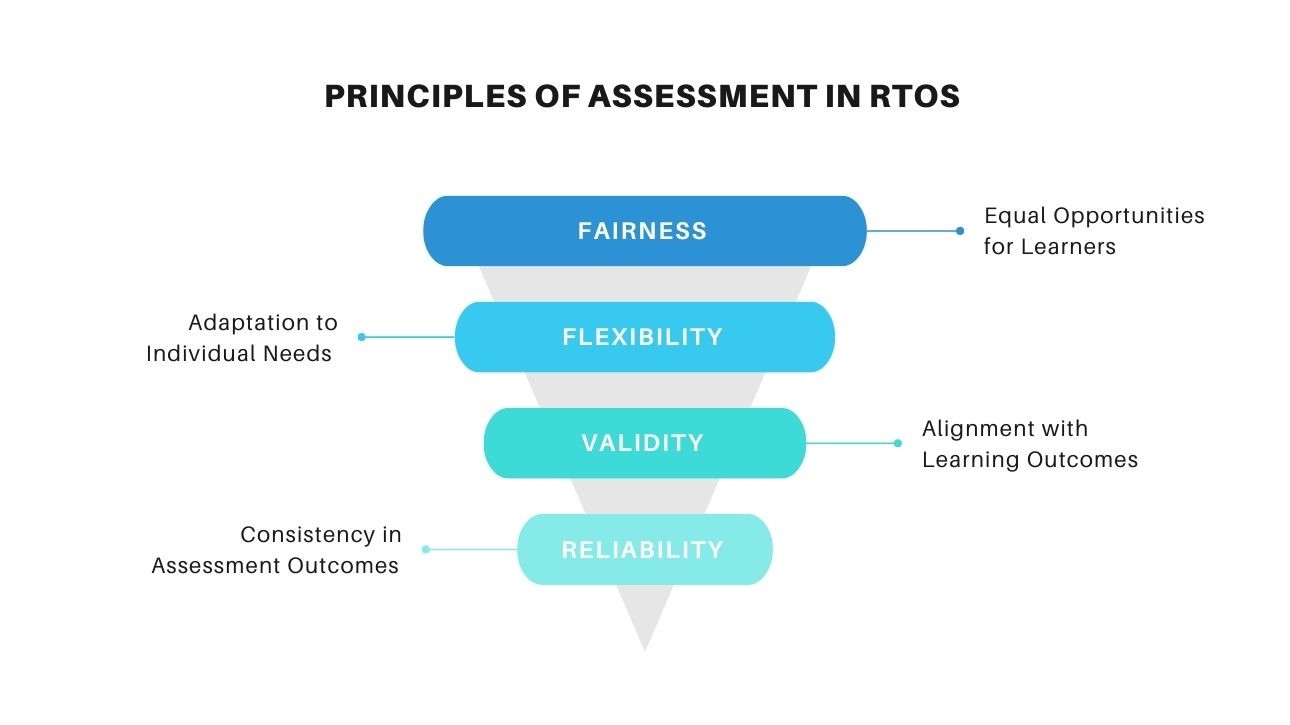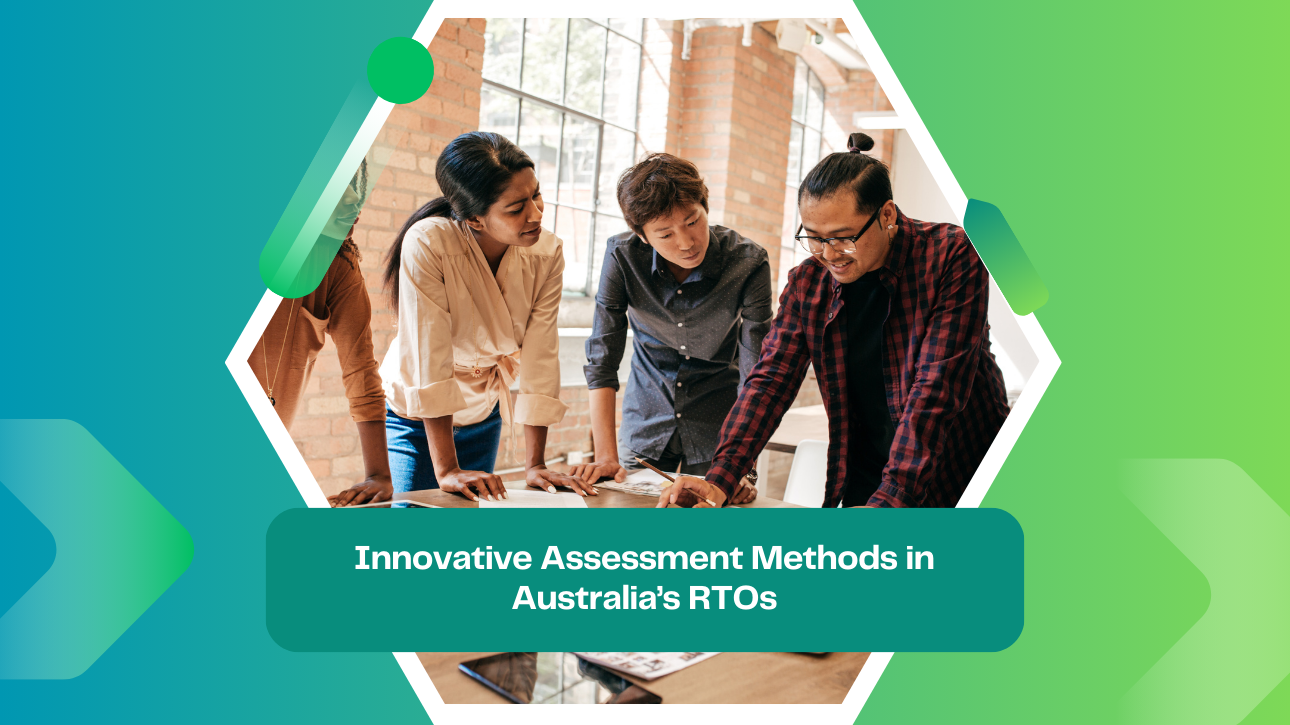Introduction
In Australia’s Registered Training Organisations (RTOs), the crucial role of the assessment method is straightforward. These organisations employ traditional and innovative assessment strategies, such as authentic assessment, role play, and experiential learning, to enhance student learning experiences and outcomes. The journey begins with a meticulously crafted assessment plan, guiding the multifaceted assessment process through various assessment types and tasks. Whether exploring the realm of threatened species or delving into the intricacies of the Australian Government initiatives, students engage in a diverse array of assessment activities, each a narrative of exploration and discovery.
This exploration is about evaluating knowledge through formative and summative assessment and fostering critical thinking and a holistic approach to learning. The assessment report reflects the learner’s journey, showcasing their practical skills and understanding of subjects ranging from grammar English to Australian jurisdiction. Risk assessment and security control are paramount in this dynamic learning environment, ensuring the safety and privacy of each student’s information.
Principles of Assessment in RTOs

In Australia’s RTOs, four cornerstone principles guide the assessment process:
- Fairness: Ensuring equal opportunities for every learner, this principle focuses on creating a level playing field. It’s about:
- Adapting to individual needs
- Negotiating reasonable adjustments
- Providing clear instructions and feedback
- Flexibility: This principle is the chameleon of the assessment method. It’s about:
- Adapting assessment types and strategies
- Catering to different learning styles and needs
- Utilising various assessment tasks and mediums
- Validity: A critical component, validity is about aligning the assessment design with the learning outcomes. It ensures:
- Competent performance
- Alignment with units of competency
- Comprehensive coverage of the subject outline
- Reliability: The consistent player in the game, reliability focuses on:
- Ensuring consistent assessment outcomes
- Providing clear guidance for assessors
- Maintaining a standard of quality across assessments
Table: Overview of Assessment Principles
| Principle | Focus | Key Features |
| Fairness | Equal Opportunities for Learners | Adaptation, Reasonable Adjustments, Clarity |
| Flexibility | Adaptation to Individual Needs | Variety in Assessment Types and Strategies |
| Validity | Alignment with Learning Outcomes | Competency Alignment, Comprehensive Coverage |
| Reliability | Consistency in Assessment Outcomes | Guidance, Quality Standards |
Implementing Assessment Principles in RTOs

Implementing the principles of assessment in RTOs is a meticulous journey, ensuring each assessment task and assessment plan aligns with the guiding principles. Here’s how it’s done:
- Planning:
- Identifying Assessment Requirements: A deep dive into the curriculum to pinpoint what needs to be assessed.
- Considering Feedback from Industry: Incorporating real-world insights to make assessments relevant and practical.
- Designing:
- Creating Assessment Tools: Crafting tools that align with ASQA guidelines and cover a spectrum of skills and knowledge.
- Ensuring Coverage: Every topic is thoroughly covered, from grammar English to Australian jurisdiction.
- Quality Checks:
- Confirming Repeatability of Performance: Ensuring assessments yield consistent results.
- Ensuring Reliability: Upholding the standard of quality across all assessments.
- Utilizing Technology in Assessment:
- Cloud Assess Software: A digital platform enhancing the assessment process.
- Benefits of Digital Assessment Tools: Efficiency, accuracy, and real-time feedback.
- Challenges and Solutions in Implementation:
- Adapting to Diverse Learning Needs: Employing a variety of assessment types and strategies.
- Maintaining Fairness and Flexibility: Balancing adaptability with the integrity of learning outcomes.
Table: Steps in Implementing Assessment Principles
| Steps | Key Actions | Focus Areas |
| Planning | Identifying Requirements, Considering Feedback | Curriculum, Industry Relevance |
| Designing | Creating Tools, Ensuring Coverage | ASQA Guidelines, Comprehensive Coverage |
| Quality Checks | Confirming Repeatability, Ensuring Reliability | Consistency, Quality Standards |
| Utilizing Technology | Implementing Digital Platforms | Efficiency, Real-time Feedback |
| Addressing Challenges | Adapting Strategies, Maintaining Fairness | Diverse Learning Needs, Integrity of Outcomes |
Detailed Assessment Procedure in RTOs
Implementing innovative assessment methods in RTOs involves a step-by-step procedure, ensuring each assessment task is meticulously planned and executed:
- Prepare for Assessment:
- Establish Context: Understand the purpose of the evidence to be collected.
- Identify Evidence Requirements: Analyze units and Training Package.
- Review Assessment Tools: Confirm their currency and adequacy.
- Prepare the Candidate:
- Explain the Assessment: Clarify the context, purpose, and process.
- Assess Candidate Needs: Negotiate reasonable adjustments if necessary.
- Determine Readiness: Decide on the time and place of the assessment.
- Plan and Prepare the Evidence-Gathering Process:
- Gather Quality Evidence: Ensure validity and reliability.
- Develop Assessment Materials: Support the evidence-gathering process.
- Organise Resources: Coordinate with other personnel involved.
- Collect Evidence and Make Assessment Decision:
- Oversee Evidence-Gathering: Ensure fairness and flexibility.
- Evaluate Evidence: Consider the four dimensions of competency.
- Make a Judgement: Record details and decide on the candidate’s competence.
- Provide Feedback on the Assessment:
- Give Constructive Feedback: Discuss the assessment outcome.
- Address Gaps in Competency: Offer information on reassessment and appeals.
- Record and Report the Result:
- Maintain Records: Adhere to the policies and procedures of the RTO.
- Issue Statements of Attainments: Comply with RTO Qualifications and Statements Issuance Policy.
- Management of Written Assessment Documents:
- Protect Assessment Evidence: Ensure the integrity of the assessment process.
- Return Marked Assessments: Secure storage and confidentiality.
- Review the Assessment Process:
- Evaluate the Process: Suggest improvements if necessary.
- Participate in Continuous Improvement: Provide input to assessment validation.
- Participate in the Reassessment and Appeals Process:
- Provide Feedback and Counselling: Inform about the reassessment and appeals process.
- Report Disputed Decisions: Participate according to the policies and procedures of the RTO.
The Role of Technology in Assessment Methods

In the modern era, technology plays an essential role in enhancing the assessment method in Australia’s RTOs. Here’s how technology is making a significant impact:
- Digital Assessment Platforms:
- Cloud Assess: A platform that streamlines the assessment process, offering real-time feedback and efficiency.
- Online Exams: Utilizing technology to conduct exams, ensuring accessibility and adaptability.
- Interactive Learning Tools:
- Interactive eBooks: Engaging students in a dynamic learning process with multimedia elements.
- Media Production: Creating visual and auditory learning materials, enhancing the learning experience.
- Real-Time Feedback:
- Instant Assessment Reports: Providing immediate insights into student learning and performance.
- Adaptive Learning Paths: Tailoring the learning journey based on individual needs and progress.
- Accessibility and Inclusivity:
- Adaptive Technologies: Ensuring that assessment tasks and materials are accessible to all learners.
- Diverse Learning Materials: Offering a variety of resources catering to different learning styles and needs.
- Security and Integrity:
- Secure Online Platforms: Protecting student information and assessment outcomes.
- Reliable Assessment Tools: Maintaining the integrity of the assessment procedure and results.
Table: Technology’s Impact on Assessment Methods
| Aspect | Technologies Used | Impact on Assessment Method |
| Digital Platforms | Cloud Assess, Online Exams | Streamlining Process, Real-Time Feedback |
| Interactive Learning | Interactive eBooks, Media Production | Enhancing Learning Experience, Engagement |
| Real-Time Feedback | Instant Reports, Adaptive Learning | Immediate Insights, Personalized Learning Path |
| Accessibility | Adaptive Technologies, Diverse Materials | Inclusivity, Catering to Diverse Needs |
| Security & Integrity | Secure Platforms, Reliable Tools | Protecting Information, Maintaining Integrity |
Challenges and Solutions in Assessment Methods
In the pursuit of excellence in assessment methods within RTOs, several challenges arise, but with every challenge comes a solution.
Table: Challenges and Solutions in Assessment Methods
| Challenge | Solution |
| Diverse Learning Needs | Variety in Assessment Types, Adaptability, Inclusivity |
| Maintaining Fairness and Flexibility | Balancing Adaptability with Integrity of Outcomes |
| Integration of Technology | Continuous Adaptation and Alignment with Evolving Needs |
| Security and Privacy Concerns | Stringent Security Measures, Safeguarding Information |
| Adherence to Standards and Regulations | Regular Review, Compliance with Guidelines and Standards |
Conclusion
In Australia’s diverse and dynamic landscape of Registered Training Organisations (RTOs), the evolution of assessment methods is a testament to the commitment to quality education and learner-centric approaches. From the foundational principles of fairness, flexibility, validity, and reliability to the meticulous implementation of detailed assessment procedures, RTOs are shaping the future of education with innovation and integrity.
- Embracing Technology: The integration of digital platforms like Cloud Assess and the development of interactive learning tools are revolutionizing the assessment process, offering real-time feedback, enhancing accessibility, and ensuring the security of student information.
- Addressing Challenges: Whether adapting to diverse learning needs or upholding the highest standards of fairness and flexibility, RTOs are meeting challenges head-on, implementing solutions that safeguard the integrity of learning outcomes and the assessment experience.
- Continuous Improvement: The journey doesn’t end here. With a commitment to continuous improvement and adaptability, RTOs are poised to explore new horizons, adapt to emerging needs, and set new benchmarks in assessment methods.
Call to Action: For those seeking to delve deeper into the world of vocational education and training, exploring VET Resources is a step towards gaining insights, understanding best practices, and staying abreast of the latest developments in assessment methods within Australia’s RTOs.
Frequently Asked Questions (FAQs)
- What are the different assessment methods used in RTOs, and how do they contribute to the application of knowledge?
- Answer: In RTOs, various assessment methods are employed, including practical tasks, written exams, and oral presentations. These methods facilitate the application of knowledge by allowing learners to demonstrate their skills and understanding in diverse ways. Sample assessment methods include role plays, case studies, and project reports, each tailored to assess specific learning outcomes.
- How can learners of English, including those familiar with vocabulary in Hindi and Mandarin Chinese characters, find appropriate assessment methods in RTOs?
- Answer: RTOs offer a range of appropriate assessment methods to accommodate learners of English, including those familiar with vocabulary in Hindi and Mandarin Chinese characters. These methods are designed to assess linguistic competence and adapt to the diverse linguistic backgrounds of learners. Resources such as the Collins English Dictionary can be helpful for learners to understand and use English vocabulary effectively in assessments.
- Can you provide a list of assessment strategies and a set of steps for the assessment process examples in RTOs?
- Answer: Certainly! A list of assessment strategies in RTOs might include formative assessments, summative assessments, peer assessments, and self-assessments. Each strategy serves a unique purpose in evaluating learners’ progress and performance. The assessment process in RTOs typically follows steps such as planning, designing, conducting, providing feedback, and reviewing, ensuring a comprehensive and fair evaluation of learners’ abilities.
Disclaimer:
The information presented on the VET Resources blog is for general guidance only. While we strive for accuracy, we cannot guarantee the completeness or timeliness of the information. VET Resources is not responsible for any errors or omissions, or for the results obtained from the use of this information. Always consult a professional for advice tailored to your circumstances.






